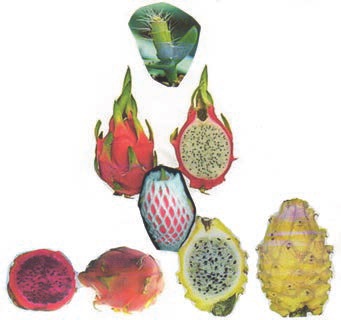|
Read 12930641 times
Connect me to:
|
Fire Dragon FruitFruits, Desserts, and Other Sweet Foods
Summer Volume: 2018 Issue: 25(2) page(s): 11
These oval-shaped fruits are members of the Castaceae or cactus family. They can be white, yellow, or red inside; red, white, or yellow on their outsides, too. All have tiny black seeds within, as the pictures on this page show, all except the very top one as it is just starting to grow. It does show a relationship to the cactus. The small crunchy black seeds are edible, the fruits are best when chilled, we like to cut them in half lengthwise, spoon out their centers, then enjoy them. Years ago, royalty kept them in ice houses for their own use; they too enjoyed them chilled. Called pitahaya or pitaya where they originated which may have been in Mexico, they are loved for their interior, their juice, and when the center part is made into a syrup and used to color candies, or in pastries. 
Sweet and refreshing, they have lots of Vitamin C and fiber, their exterior has spikes some call their ‘wings,’ and they are now popular in China and called longguo. We were introduced to them in Taipei at a street stand, their shell-like exterior
did serve as a dish, and there, the foods in them looked lovely. Their flowers are aromatic and bloom for only one night we were told. Some cook them/or the fruits as a vegetable we never have. Most just spoon out their chilled interior, cut them into cubes, and use them as a dessert or in a main dish. Some call the all red ones ‘strawberry pears’ as they can be red inside and out. Most are white with their black dots, but they can be red, pink, yellow or white, though the insides of the yellow and red ones are often that color. They now grow in Southern Florida, Hawaii, and many Pacific locales so look for them in warm weather. One story about them from 1830, tells of a boatload
reaching Hawaii from Mexico. They were on their way to
Boston, then on to Guangzhou. The captain thought they
looked dead and should be discarded. He wondered if
they had any life left. With that in mind, he ordered them
planted on that layover. His mates were surprised to see
them take root on their return stopover. This helped
others see possibilities for their use as rootstocks or for grafting purposes, and as ornamentals. Now, they are
commonly used in these fashions and as flowers and
fruits. These plants have many relatives including Hylocereus undatus, a
night-blooming cereus, the apple cactus,
and Cereus camponis cultivated in Guatemala, Columbia, Bolivia, and Puerto Rico. Large, erect,
multiple-stemmed, ribbed, some spiny, they now grow
in many places where some say they have the texture
but not the color of kiwi fruit. Pitahaya fruits stay three to six days in the refrigerator, many reminding their users of sherbet. In China and elsewhere, some grow on rocks, creep on stone walls and branches or bushes, and some hang off them. Some royals did keep them in ice-houses for weeks or months, or in vertical boxes loaded top to bottom with blocks of ice. The flowers of this plant bloom at night and usually wilt by morning. They set as fruit, and the one in the center shows how they are wrapped for shipping. These fruits rely on nocturnal pollination from bats, moths, or beetles, and can flower as many as six times in a year. Low in calories, should one break a stem, they often do take root when stuck in the ground thereafter. People love these fruits plain or mixed with other fruits. We know not why very few recipes exist for them. The one below we have made often, and other than chilled and spooned or cubed into their shells, we have found no other recipes that inspire their use. | Dragon Fruit, Bean Paste, and Lotus Seeds |
|---|
Ingredients:
½ cup dried lotus seeds, soaked overnight
¼ cup red bean seeds, soaked overnight
1 kiwi fruit, peeled and cubed
4 Tablespoons rock sugar, divided
2 or 3 dragon fruits, their insides scooped out and gently mashed
Preparation:
1. Simmer lotus seeds in two or three cups of boiling
water and half the rock sugar for one hour, then drain,
mash, and cool them.
2. Simmer red beans in another pot in two to three cups
of boiling water for one hour with the other half of the
rock sugar, then drain, mash, and cool them.
3. Put mashed lotus seeds and red beans in the empty
dragon fruit shells, top with the kiwi cubes, and serve at
room temperature.
|
|


